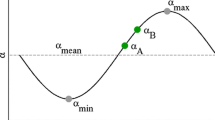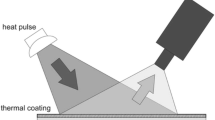Abstract
Differential infrared thermography (DIT) is a method of analyzing infrared images to measure the unsteady motion of the laminar–turbulent transition of a boundary layer. It uses the subtraction of two infrared images taken with a short-time delay. DIT is a new technique which already demonstrated its validity in applications related to the unsteady aerodynamics of helicopter rotors in forward flight. The current study investigates a pitch-oscillating airfoil and proposes several optimizations of the original concept. These include the extension of DIT to steady test cases, a temperature compensation for long-term measurements, and a discussion of the proper infrared image separation distance. The current results also provide a deeper insight into the working principles of the technique. The results compare well to reference data acquired by unsteady pressure transducers, but at least for the current setup DIT results in an additional measurement-related lag for relevant pitching frequencies.
Graphical abstract

























Similar content being viewed by others
Abbreviations
- \(1\text{MG}\) :
-
One-meter wind-tunnel Göttingen
- DIT:
-
Differential infrared thermography
- DLR:
-
German Aerospace Center
- IT:
-
Infrared thermography
- c :
-
Chord length, \(c={0.3\,\hbox {m}}\)
- \(c_\mathrm{f}\) :
-
Skin-friction coefficient
- \(c_\mathrm{l}\) :
-
Lift coefficient
- \(c_\mathrm{p}\) :
-
Pressure coefficient
- C :
-
Fluid specific heat capacity, J/m\(^3\)/K
- f :
-
Pitching frequency, Hz
- k :
-
Reduced frequency, \(k = \pi f c/V_\infty\)
- \(\text{M}_\infty\) :
-
Freestream Mach number
- \({\dot{q}}_\mathrm{c}\) :
-
Convective heat flux, W/m\(^3\)
- Re:
-
Reynolds number
- t :
-
Time, s
- T :
-
Airfoil surface temperature, K or counts
- \(T_\infty\) :
-
Freestream temperature, K
- \(V_\infty\) :
-
Freestream velocity, m/s
- x :
-
Coordinate along the airfoil’s chord line, m
- \(x_{\text{tr}}\) :
-
Transition position, m
- \(\alpha\) :
-
Geometric angle of attack, deg
- \({\overline{\alpha }}\) :
-
Mean value of the angle of attack, deg
- \({\widehat{\alpha }}\) :
-
Amplitude of the angle of attack, deg
- \(\varDelta\) :
-
Difference between two values
- \(\varDelta T_\mathrm{p}\) :
-
DIT peak height, counts
- \(\rho\) :
-
Density, kg/m\(^3\)
- \(\sigma C_\mathrm{p}\) :
-
Standard deviation of the pressure coefficient
References
Coder JG (2017) OVERFLOW rotor simulations using advanced turbulence and transition modeling. In: 55th AIAA aerospace sciences meeting, AIAA SciTech Forum, Grapevine, TX, USA, Jan 9–13, 2017. https://doi.org/10.2514/6.2017-1432
Drela M (1990) Newton solution of coupled viscous/inviscid multielement airfoil flows. In: AIAA 21st fluid dynamics, plasma dynamics and lasers conference, Seattle, WA, USA, June 18–20, 1990. https://doi.org/10.2514/6.1990-1470
Gardner AD, Richter K (2015) Boundary layer transition determination for periodic and static flows using phase-averaged pressure data. Exp Fluids 56(6):119. https://doi.org/10.1007/s00348-015-1992-9
Gardner AD, Richter K (2016) New results in numerical and experimental fluid mechanics X, Springer International Publishing, chap transition determination on a periodic pitching airfoil using phase averaging of pressure data, pp 291–301. https://doi.org/10.1007/978-3-319-27279-5_26
Gardner AD, Wolf CC, Raffel M (2016) A new method of dynamic and static stall detection using infrared thermography. Exp Fluids 57(9):149. https://doi.org/10.1007/s00348-017-2405-z
Gardner AD, Eder C, Wolf CC, Raffel M (2017) Analysis of differential infrared thermography for boundary layer transition detection. Exp Fluids 58(9):122. https://doi.org/10.1007/s00348-017-2405-z
Goerttler A, Gardner AD, Richter K (2017) New results in numerical and experimental fluid mechanics XI, Springer International Publishing, chap unsteady boundary layer transition detection by automated analysis of hot film data, pp 387–396. https://doi.org/10.1007/978-3-319-64519-3_35
Lorber PF, Carta FO (1992) Unsteady transition measurements on a pitching three-dimensional wing. In: Fifth symposium on numerical and physical aspects of aerodynamic flows, Long Beach, CA, USA, Jan 13–15, 1992
Merz CB, Wolf CC, Richter K, Kaufmann K, Mielke A, Raffel M (2017) Spanwise differences in static and dynamic stall on a pitching rotor blade tip model. J Am Helicopter Soc 62(1):1–11. https://doi.org/10.4050/JAHS.62.012002
Overmeyer A, Heineck JT, Wolf CC (2018) Unsteady boundary layer transition measurements on a rotor in forward flight. In: 74th annual forum of the American Helicopter Society, Phoenix, AZ, USA, May 14–17, 2018
Overmeyer AD, Martin PB (2017a) The effect of laminar flow on rotor hover performance. In: 73rd annual forum of the American Helicopter Society, Fort Worth, TX, USA, May 9–11, 2017
Overmeyer AD, Martin PB (2017b) Measured boundary layer transition and rotor hover performance at model scale. In: 55th AIAA aerospace sciences meeting, AIAA SciTech Forum, Grapevine, TX, USA, Jan 9–13, 2017. https://doi.org/10.2514/6.2017-1872
Raffel M, Merz CB (2014) Differential infrared thermography for unsteady boundary-layer transition measurements. AIAA J 52(9):2090–2093. https://doi.org/10.2514/1.J053235
Raffel M, de Gregorio F, de Groot K, Schneider O, Sheng W, Gibertini G, Seraudie A (2011) On the generation of a helicopter aerodynamic database. Aeronaut J 115(1164):103–112. https://doi.org/10.1017/S0001924000005492
Raffel M, Merz CB, Schwermer T, Richter K (2015) Differential infrared thermography for boundary layer transition detection on pitching rotor blade models. Exp Fluids 56(2):30. https://doi.org/10.1007/s00348-015-1905-y
Raffel M, Gardner AD, Schwermer T, Merz CB, Weiss A, Braukmann J, Wolf CC (2017) Rotating blade stall maps measured by differential infrared thermography. AIAA J 55(5):1753–1756. https://doi.org/10.2514/1.J055452
Richter K, Schülein E (2014) Boundary-layer transition measurements on hovering helicopter rotors by infrared thermography. Exp Fluids 55(7):1755. https://doi.org/10.1007/s00348-014-1755-z
Richter K, Schlein E, Ewers B, Raddatz J, Klein A (2016a) Boundary layer transition characteristics of a full-scale helicopter rotor in hover. In: 72nd annual forum of the American Helicopter Society, West Palm Beach, FL, USA, May 17–19, 2016
Richter K, Wolf CC, Gardner AD, Merz CB (2016b) Detection of unsteady boundary layer transition using three experimental methods. In: 54th AIAA aerospace sciences meeting, San Diego, CA, USA, Jan 4–8, 2016
Schreck SJ, Faller WE, Helin HE (1998) Pitch rate and reynolds number effects on unsteady boundary-layer transition and separation. J Aircr 35(1):46–52. https://doi.org/10.2514/2.2258
Schülein E (2008) Experimental investigation of laminar flow control on a supersonic swept wing by suction. In: 4th flow control conference, fluid dynamics and co-located conferences, Seattle, WA, USA, June 23–26, 2008. https://doi.org/10.2514/6.2008-4208
Schülein E (2014) Optical method for skin-friction measurements on fast-rotating blades. Exp Fluids 55(2):1672. https://doi.org/10.1007/s00348-014-1672-1
Tanner W, Yaggy P (1966) Experimental boundary layer study on hovering rotors. J Am Helicopter Soc 11(3):22–37. https://doi.org/10.4050/JAHS.11.22
Truckenbrodt EA (2008) Fluidmechanik Band 2: Elementare Strömungsvorgänge dichteveränderlicher Fluide sowie Potential- und Grenzschichtströmungen. Springer, Berlin
Vieira BA, Kinzel MP, Maughmer M (2017) CFD hover predictions including boundary-layer transition. In: 55th AIAA aerospace sciences meeting, AIAA SciTech Forum, Grapevine, TX, USA, Jan 9–13, 2017. https://doi.org/10.2514/6.2017-1665
Wadcock AJ, Yamauchi GK, Driver DM (1999) Skin friction measurements on a hovering full-scale tilt rotor. J Am Helicopter Soc 44(4):312–319. https://doi.org/10.4050/JAHS.44.312
Weiss A, Gardner AD, Klein C, Raffel M (2017) Boundary-layer transition measurements on mach-scaled helicopter rotor blades in climb. CEAS Aeronaut J 8(4):613–623. https://doi.org/10.1007/s13272-017-0263-2
Acknowledgements
The studies were conducted in the framework of the DLR project “FAST-Rescue”.
Author information
Authors and Affiliations
Corresponding author
Additional information
Publisher's Note
Springer Nature remains neutral with regard to jurisdictional claims in published maps and institutional affiliations.
Rights and permissions
About this article
Cite this article
Wolf, C.C., Mertens, C., Gardner, A.D. et al. Optimization of differential infrared thermography for unsteady boundary layer transition measurement. Exp Fluids 60, 19 (2019). https://doi.org/10.1007/s00348-018-2667-0
Received:
Revised:
Accepted:
Published:
DOI: https://doi.org/10.1007/s00348-018-2667-0




